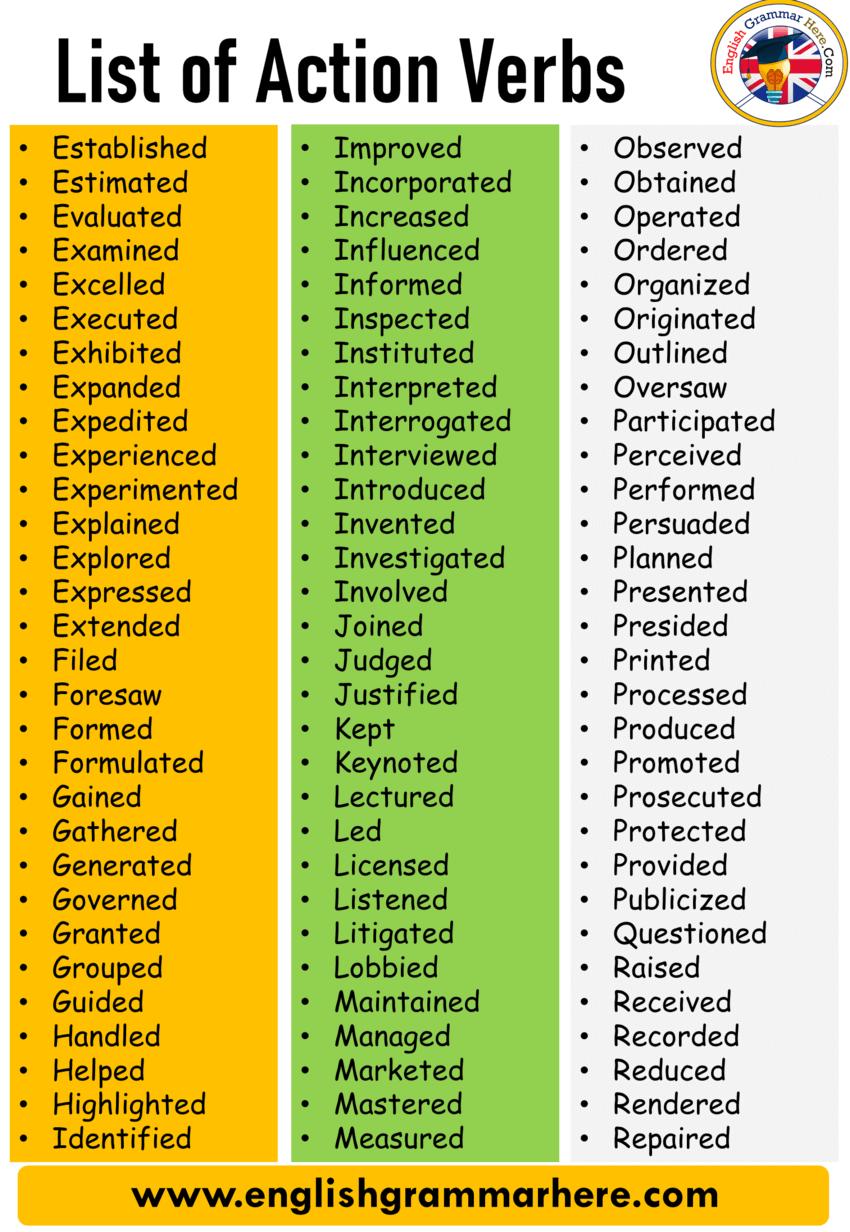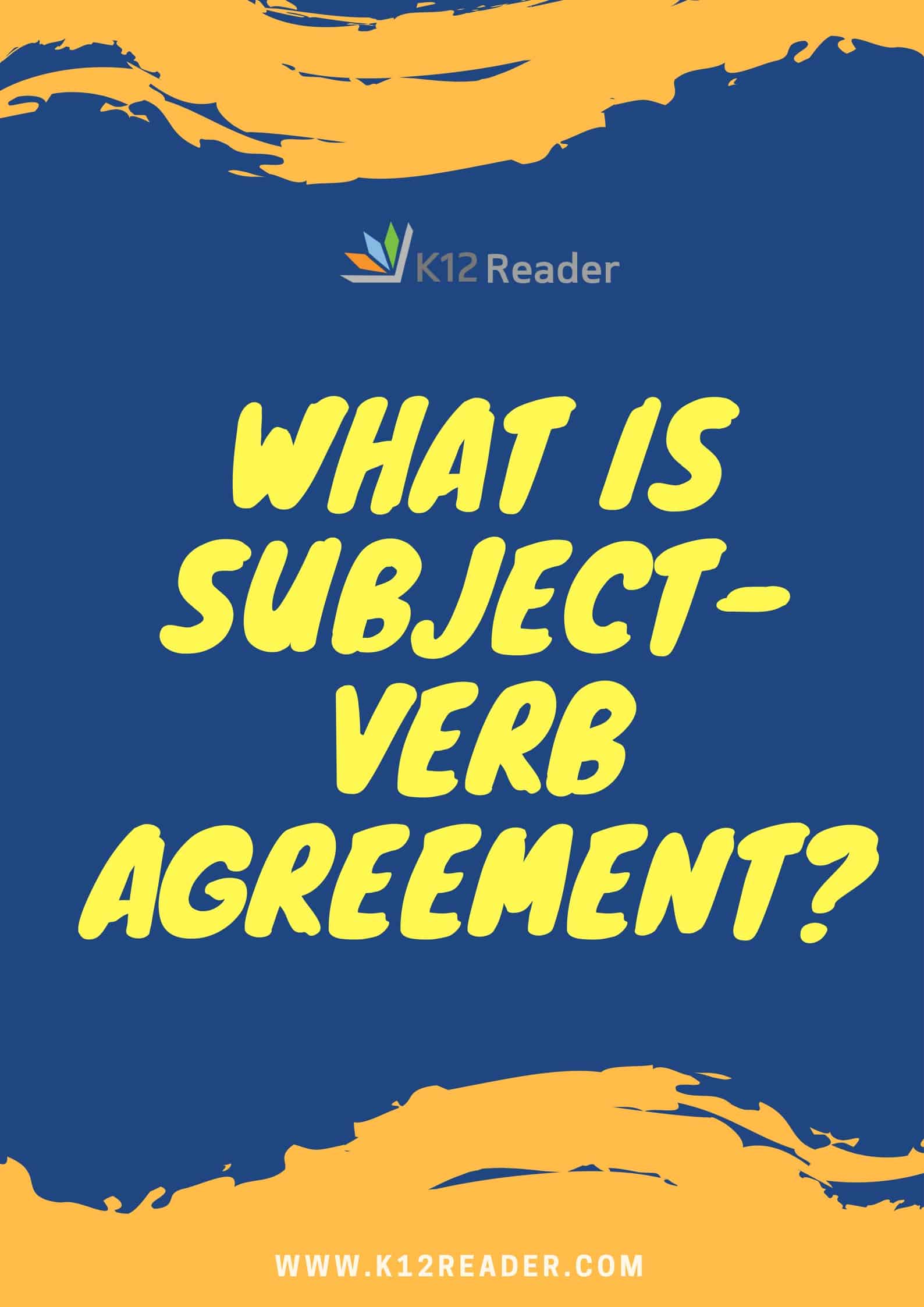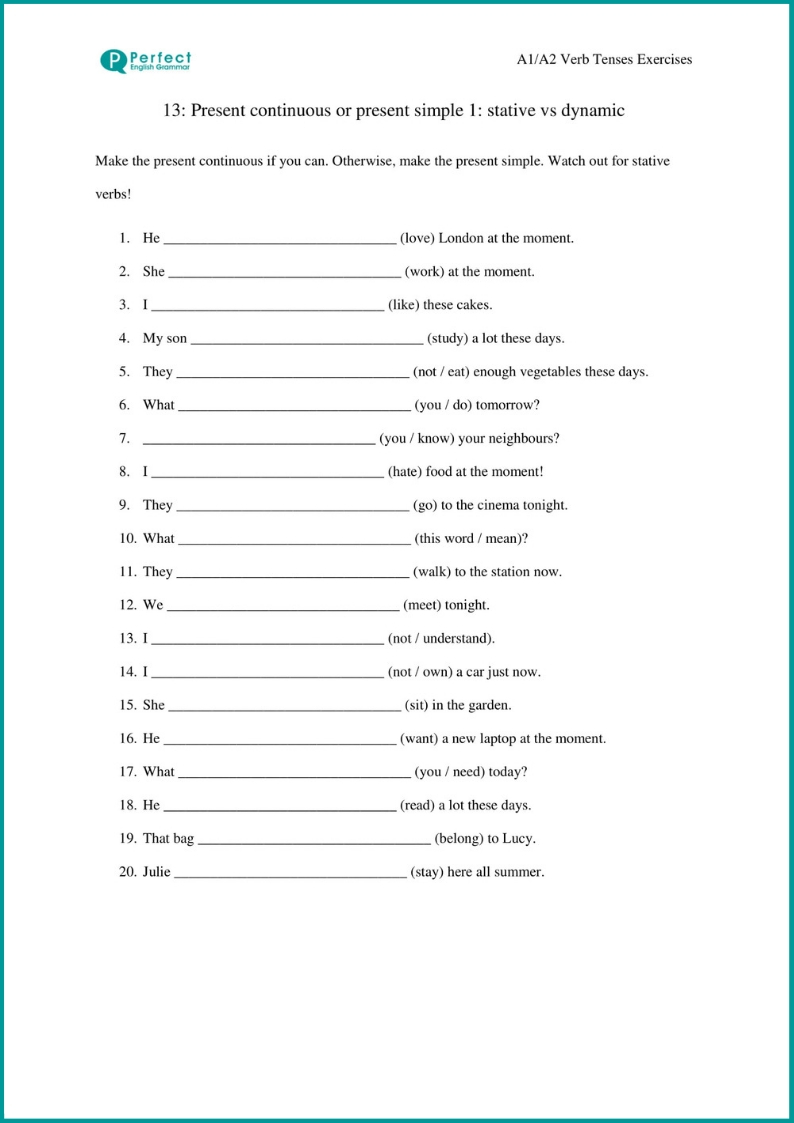Verbs express the action performed by the subject or the subject's state of being. Sentences can contain more than one verb, or a verb phrase. However, action and linking verbs are infinitive phrases, not main verbs, when they follow the word "to." Auxiliary verbs usually accompany an infinitive verb or a participle, which respectively provide the main semantic content of the clause. An example is the verb have in the sentence I have finished my lunch.
Here, the auxiliary have helps to express the perfect aspect along with the participle, finished. Some sentences contain a chain of two or more auxiliary verbs. Auxiliary verbs are also called helping verbs, helper verbs, or auxiliaries. Research has been conducted into split inflection in auxiliary verbs. Except for the linking verb list, the other categories break down into different types.
The next list of verbs can be physical or mental. The list of helping verbs can be auxiliary or modal. The list of irregular verbs shows verbs in different tenses. Use auxiliary verbs before other verbs to form questions, passives and negative sentences, a compound tense or the passive.
Auxiliary verbs are also known as helping verbs. These verbs give us more information about the main verb in a sentence often to give us more detail about time. That is why they are used in progressive and perfect tense sentences. Native English speakers can use helping verbs and modal auxiliary verbs without giving the grammar a second thought.
Of course, that's only true if we're talking about working in English. If you're learning a foreign language, you need to learn how its speakers express tense, voice, and mood. A good starting point for understanding how they do it is understanding how we do it.
For the next little while, we're going to focus on main verbs. So, forget about those poor little helping verbs for a bit, and let's turn our attention to action verbs and linking verbs. These two kinds of main verbs can act in four different ways.
Both modals and auxiliaries can be found on a list of helping verbs. Modals are usually followed by the infinitive of another verb. Just like the list of linking verbs, the list of modals within the list of helping verbs is also small and therefore easy to remember. A verbs list with modal verbs is given below. Identify the main verb in a sentence containing multiple verbs but no verb phrase by asking yourself which verb is expressing the subject's action or state of being.
For example, in the sentence "John learned to tie his shoes," both "learned" and "tie" are action verbs. However, "tie" follows the word "to," so "tie" is part of an infinitive phrase and does not express the main action of the sentence. "Learned" is the main verb because John performed the action of learning, and tying his shoe is what he learned, not the action he performed. Although there are a variety of auxiliary verbs in the English language, the following words are a few that often function as helping verbs. Note that these auxiliary verbs may function as action or linking verbs in other cases. Auxiliary verbs are also called helping verbs.
An auxiliary verb extends the main verb by helping to show time, tense, and possibility. The auxiliary verbs are – be verbs, have, and do. The being/linking words in the sentences above are included in the being verbs list below. You can use words in the linking verbs list to connect the subject with other words in a sentence.
Modal auxiliary verbs combine with other verbs to express ideas such as necessity, possibility, intention, and ability. In these examples, the verb phrases are in bold, and the modal auxiliary verbs are highlighted. If the negative forms can't, don't, won't, etc. are viewed as separate verbs , then the number of auxiliaries increases. The verbs do and have can also function as full verbs or as light verbs, which can be a source of confusion about their status. The modal verbs form a subclass of auxiliary verbs. Modal verbs are defective insofar as they cannot be inflected, nor do they appear as gerunds, infinitives, or participles.
The Main verb and auxiliary verb are important parts of a sentence. Both of them contribute to the correct structure of a sentence. The main verb is a verb that expresses an action. In the same sentence, the auxiliary verbs 'is' and 'was' express the time of the action in both sentences. The verbs be and have are used as auxiliary verbs to form different tenses of main verbs. Be is used on its own to form the continuous tenses, while have is used to form the perfect tenses.
Both have and been are used together to form the perfect continuous tenses. Be and have are used as auxiliaries to conjugate the continuous, perfect, and perfect continuous tenses. Do is used to make main verbs negative or to form interrogative sentences, and it can also be used to add emphasis to a sentence. Sentences containing multiple verbs do not always have one main verb. Well, that's true provided we're talking about working in English. If you start learning a foreign language, it won't be too long before you'll be unpicking how they express tense, voice and mood.
And, do you know what's a good starting point for that? Main verbs come in many shapes and sizes, just like their helpers. You can spot them if you can spot an action verb or a linking verb.
Then, if you can answer the question "Who?" or "What?" after you spot the verb, you're even further down the pathway to grammatical expertise. Learn more about verbs and how they appear in a sentence with an irregular verbs list, complete with a helpful printable. For example, the sentence "Shannon is and plays in the field" doesn't make sense because is is a state of being and plays is an action verb. There are three types of verbs; action, linking and helping. Most of the verbs you will use in conversation or writing will be action verbs or linking verbs. There is also a third category of verbs which doesn't get any glory.
The reason that these guys don't get any of the fame that action and linking verbs get is because they don't stand alone as main verbs. Sometimes lexical verbs receive help from other verbs. Auxiliary verbs help main verbs to express degrees of time and mood. Auxiliary verbs aren't considered to be lexical verbs themselves.
Will, might, can, and need are helping verbs. In the sentence, "I need to go now," need is the helping verb. The words in the linking verbs list are words that connect the subject of a sentence to specific information about the subject. In other words, linking verbs connect the subject to a predicate noun or a predicate adjective. The "primary" auxiliary verbs—be, have, and do—are some of the most commonly occurring verbs in English.
… Do is used to make main verbs negative or to form interrogative sentences, and it can also be used to add emphasis to a sentence. In English grammar, a main verb is any verb in a sentence that is not an auxiliary verb. A main verb carries the meaning in a verb phrase. A main verb is sometimes preceded by one or more auxiliary verbs .
What is main verb with examples Regular and irregular verbs are categorized based on whether or not they end with a certain pattern in different tenses. These verbs are formed on the basis of how they look . A regular or an irregular verb, like any other action verb, is either a transitive verb or an intransitive verb. Some syntacticians distinguish between auxiliary verbs and light verbs. The two are similar insofar as both verb types contribute mainly just functional information to the clauses in which they appear. Inversion refers to the reversal of the normal position of the subject and the auxiliary verb of a clause.
We cannot use subject-verb inversion with main verbs to create interrogative sentences—we have to either add the auxiliary verb do, or else invert an existing auxiliary verb. Identify the main verb in a verb phrase by determining the subject's main action or state of being. Thus, "tying" is the main verb and "was" is a helping verb.
Sometimes actions or conditions occur only one time and then they're over. It's at times like these that some of the same verbs that are used as auxiliary verbs are instead used as action or linking verbs. This is one of the most common auxiliary verbs, but because it stands alone here, it is not functioning as an auxiliary verb. Just as action verbs describe what a subject does, linking verbs describe the subject in some other way. Most often, they define or describe the subject of the sentence.
Note that in the two example sentences the linking verb connects the subject to its definition. In the first sentence, Jane is defined as a nice person; in the second sentence, the new cat is identified as a possible calico. Let's now look at the modal auxiliary verbs. In each example below, the verb phrase is in bold and the modal auxiliary verb is highlighted.
Many readers think that a modal verb, such as should, must or can, is the main verb in a sentence. However, like helping verbs, modal verbs only exist to support main verbs. For example, the sentence "I should to the store" doesn't make sense; should is not a main verb. Sometimes linking verbs are the main verbs of sentences. Verbs such as to be, to seem, to become, and to feel are examples of linking verbs. Linking verbs connect subjects to their predicates.
Some verbs in this list can also be action verbs. To figure out if they are linking verbs, you should try replacing them with forms of the be verbs. If the changed sentence makes sense, that verb is a linking verb. Meanwhile, aside from changing the meaning of sentences, auxiliaries can also be combined with verbs to specify time and voice.
First of all, the verb to be and all its forms are used to create the progressive tenses of a verb. The progressive tense describes an action that happens continuously over a period of time. You may have noticed that the future tenses also use the auxiliary verb will.
This is one of the modal auxiliary verbs, which will be covered in a separate section. Determine whether the sentence contains one verb or multiple verbs by identifying the action the subject is performing or the subject's state of being. For example, the sentence "John tied his shoes" contains only the verb "tied," so there is no need to identify the main verb.
The main verb needs to be identified in both of these sentences. In formal or academic English, you need to use one main verb phrase in every clause in English. This will come directly after the subject in most clauses, because English is what's called a 'subject-dominant' language.
Read more about this in the previousblog post on sentence structure. The next verbs list you'll look at is the list of action verbs that are irregular, thus they are part of the irregular verbs list. Well, verbs that do not follow the normal rules for conjugation fall into the irregular verbs list. It is a descriptive analytical tool, designed to help you distinguish between the main verb phrase and other, especially verbal, phrases. Once you identify a main verb phrase, you can use the Main Verb Phrase formula to analyze it in the context of a particular clause.
The main verb and auxiliary verb are important parts of a sentence. If there is only one verb in a sentence, then it is by definition the main verb. Generally make aid and help as in their name. Different types of helping verbs support or encourage the main verbs in different ways. For example, we can show tense , intention, possibility or ability.
The primary helping verbs are 'to do', 'to be' and 'to have'. However, both transitive and intransitive verbs are action verbs. In each example sentence above, the subject is DOING something. Modal verbs have no tense, but they express different shades of meaning in a sentence. While they're an important part of a verb phrase, modal verbs are never the main verb.
If you're putting your sentence in a verb tense besides past or present, you're using a verb phrase. Verb phrases consist of a helping verb (usually forms of "to be," "to have" or "will") that place the main verb in the proper time period. Learn the main verb definition and see main verb examples in sentences. See how to identify the main verb and how different types of verbs are classified. When this occurs, perfect aspect is superior to progressive aspect, e.g.






























No comments:
Post a Comment
Note: Only a member of this blog may post a comment.